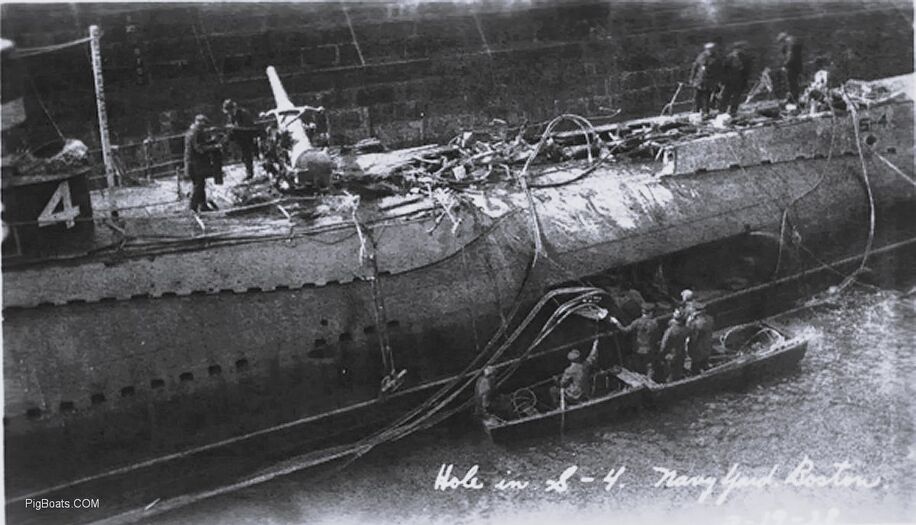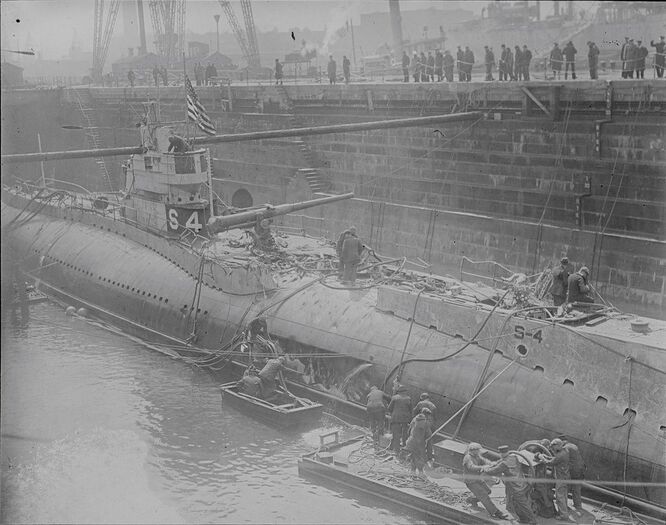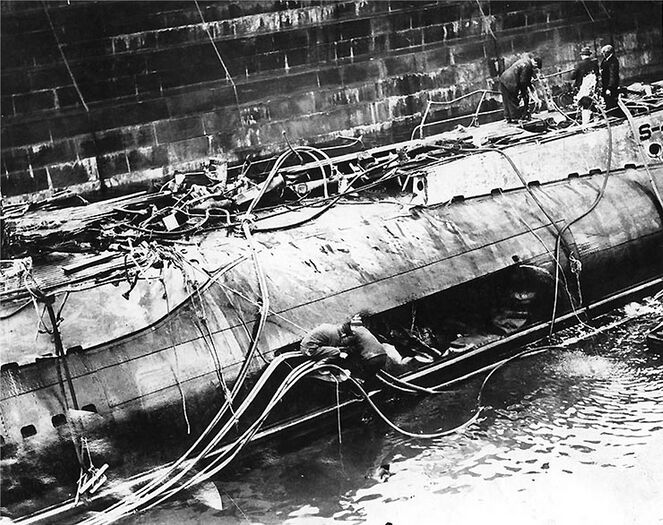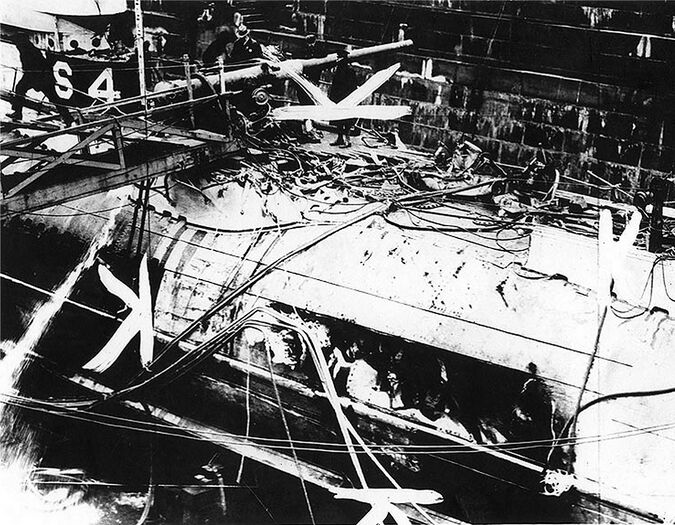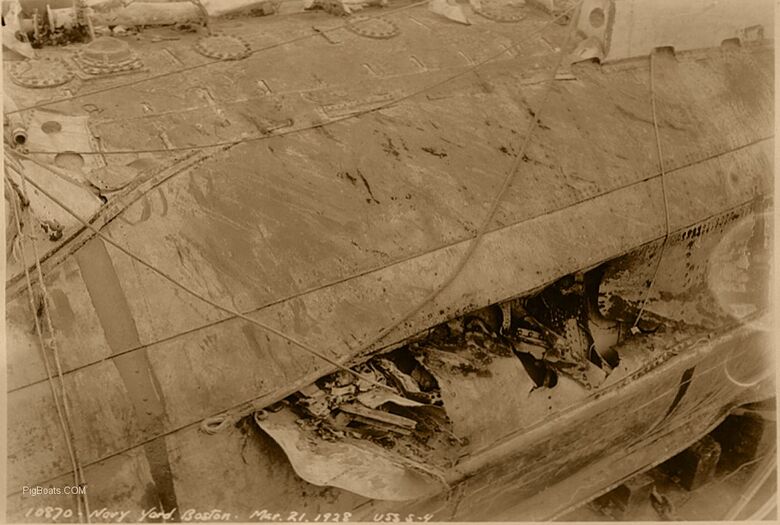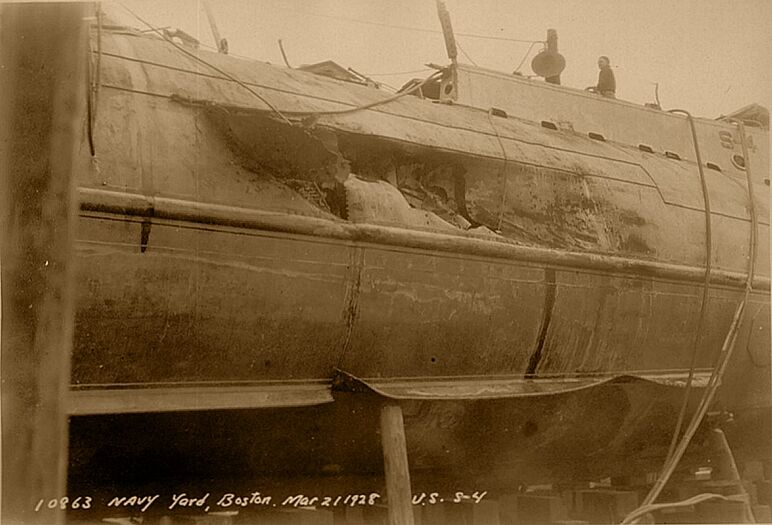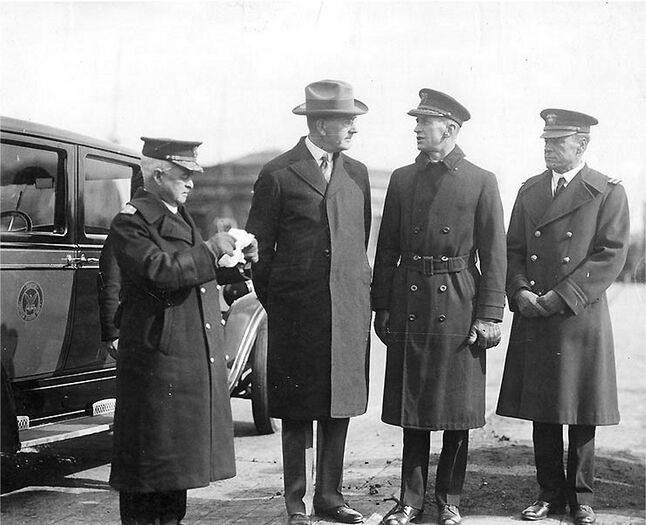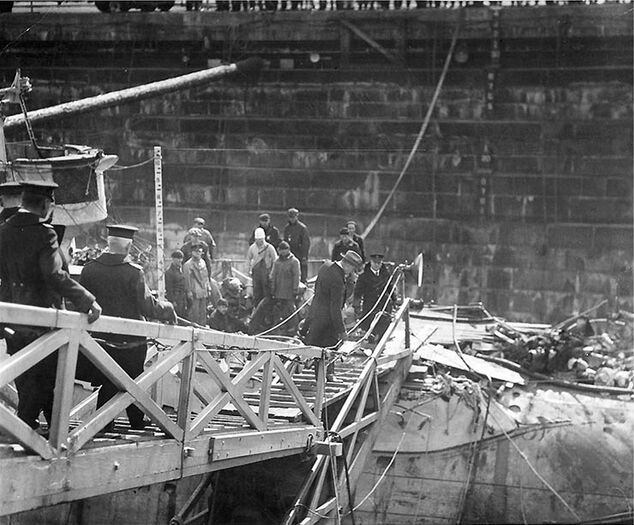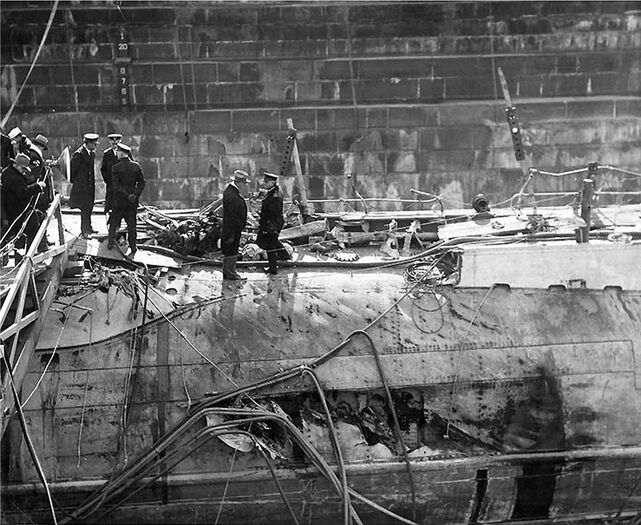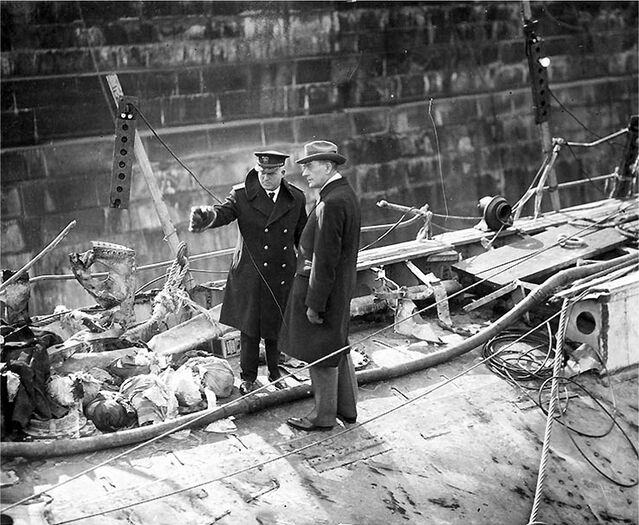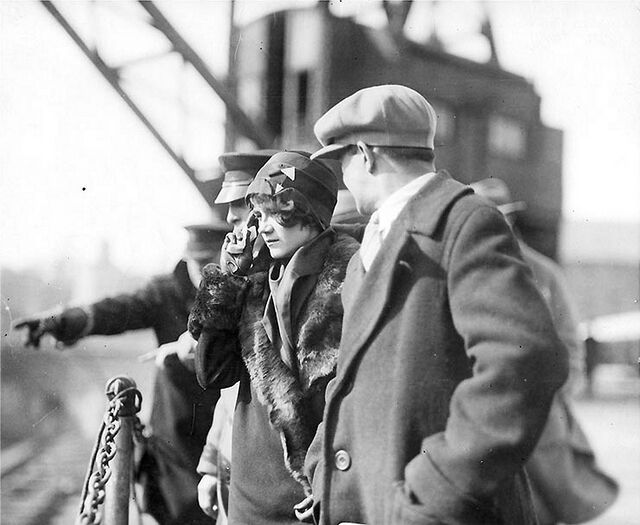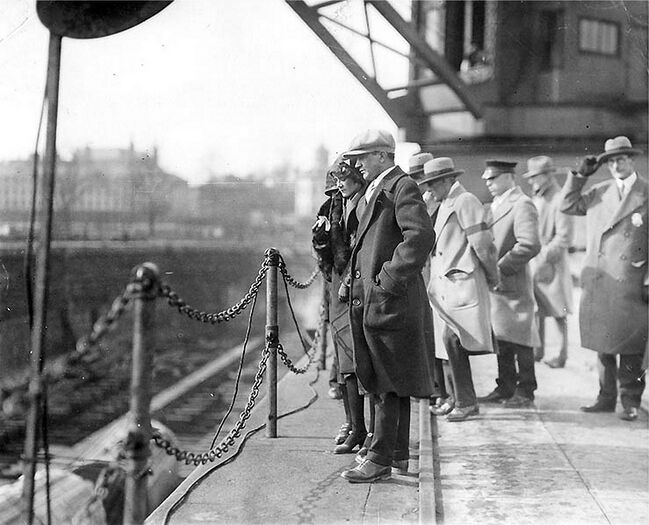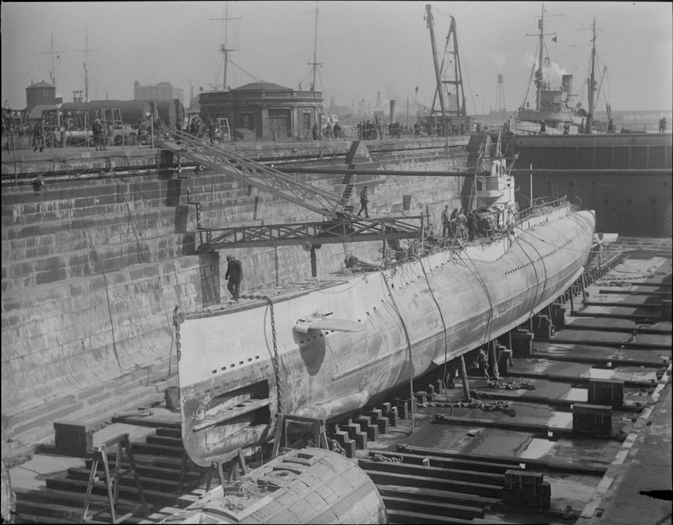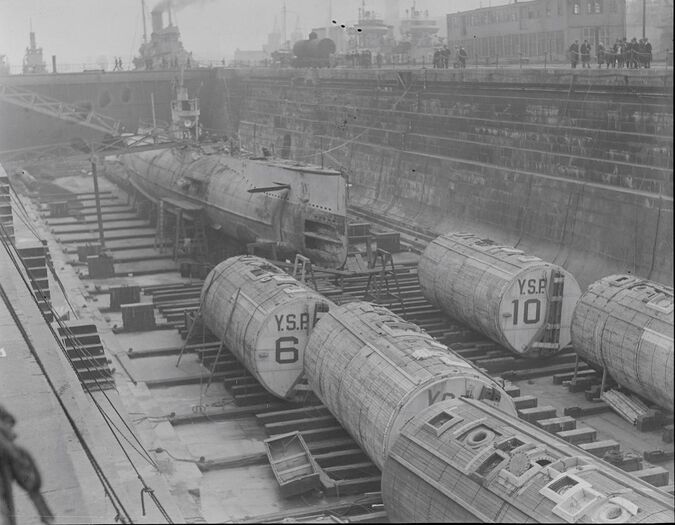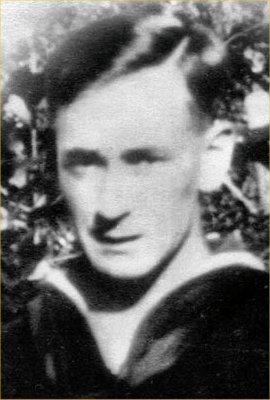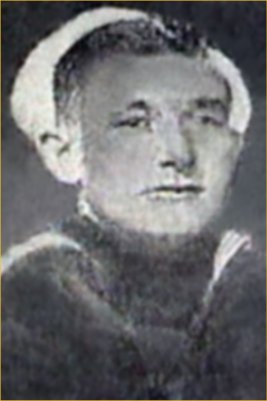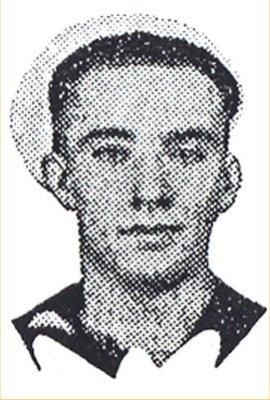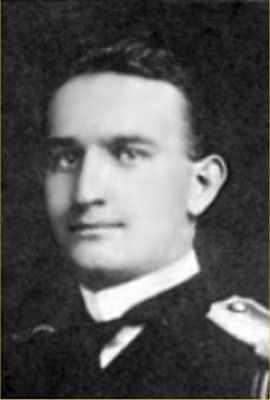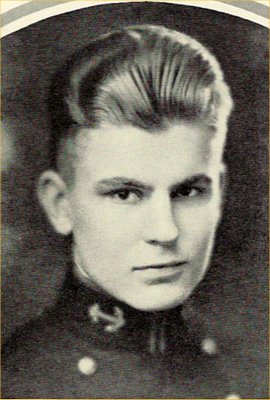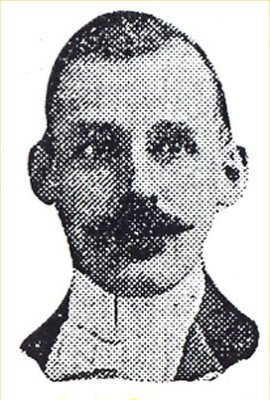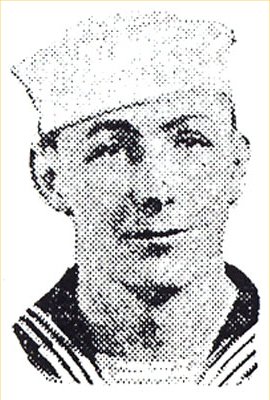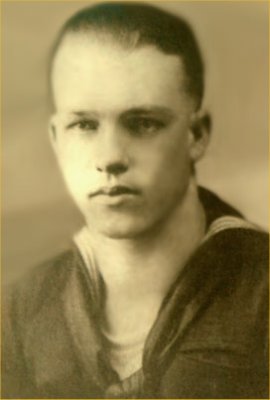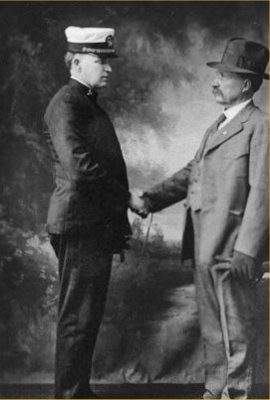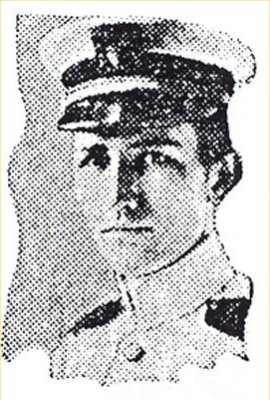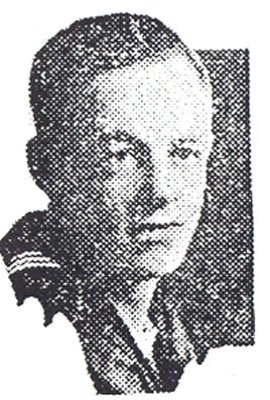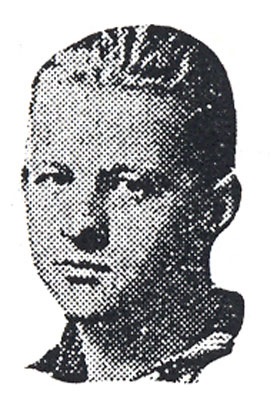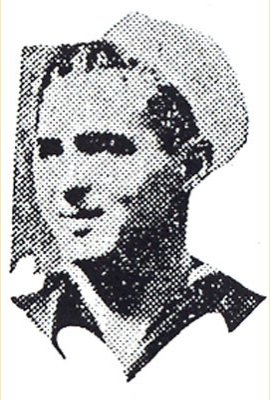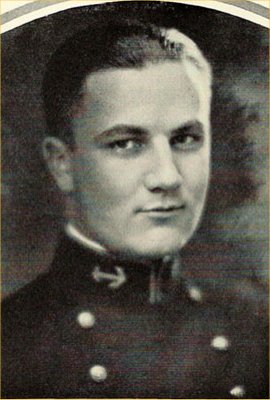S-4 salvage: Difference between revisions
Pbcjohnston (talk | contribs) |
Pbcjohnston (talk | contribs) →Damage Assessment and Inspection: Added photos, fixed formatting of galleries. |
||
| Line 126: | Line 126: | ||
<center> | <center> | ||
<gallery mode="packed" widths=" | <gallery mode="packed" perrow=2 widths="450px" heights="350px"> | ||
File:S-4 secnav.jpg | File:S-4 secnav.jpg | ||
File:S-4 secnav inspect.jpg | File:S-4 secnav inspect.jpg | ||
| Line 140: | Line 140: | ||
<center> | <center> | ||
<gallery mode="packed" widths=" | <gallery mode="packed" widths="450px" heights="350px"> | ||
File:S-4 widow 1.jpg | File:S-4 widow 1.jpg | ||
File:S-4 widow 2.jpg | File:S-4 widow 2.jpg | ||
| Line 148: | Line 148: | ||
<small>U.S. Navy photos.</small> | <small>U.S. Navy photos.</small> | ||
[[File:Red bar sub new.jpg]] | |||
[[File:S-4 remove torp.jpg|left|500px]] | |||
<div style="text-align: justify;"><span style="color:#00008B">A Mk 10 torpedo is removed from the S-4. The weapon was pushed by hand out of the torpedo tube, where a crane gingerly picked up the weapon and moved it to the pier. How many weapons the S-4 was carrying on her final voyage is not known. | |||
<small>U.S. Navy photo.</small> | |||
[[File:Red bar sub new.jpg]] | |||
<center> | |||
<gallery mode="packed" widths="450px" heights="350px"> | |||
File:S-4 in drydock from port.png | |||
File:S-4 in drydock with pontoons.jpg | |||
</gallery> | |||
</center> | |||
<div style="text-align: justify;"><span style="color:#00008B">Two more photos from the assessment phase, with most of the hoses and lines from the salvage work cleared away. The first photo shows the undamaged port side, and the second provides a good view of the salvage pontoons that were used in the salvage work. The S-4's torpedo tubes are open and the weapons stored in the torpedo room have been removed. | |||
<small>Images courtesy of the Massachusetts Digital Commonwealth.</small> | |||
[[File:Red bar sub new.jpg]] | [[File:Red bar sub new.jpg]] | ||
[[File:S-4 damage forward deck.jpg|left|500px]] | [[File:S-4 damage forward deck.jpg|left|500px]] | ||
<div style="text-align: justify;"><span style="color:#00008B">This photo was taken on March 21, 1928 | <div style="text-align: justify;"><span style="color:#00008B">This photo was taken on March 21, 1928. The 4"/50 caliber deck gun has been removed to facilitate repairs to the boat. The collision damage to the deck and superstructure in the area of the hole, (to the left in this photo), is clearly seen. At the right side is a large electrical pump that is in use pumping water from the hull. The stanchions for the radio antennas atop the bridge are bent to port as is the periscope. The two massive poles bracing the submarine to the sides of the drydock are seen running to each side of the photo. Portable lighting has been set up to allow work into the night and provide a safe area for walking due to all the damage. The round wire mesh enclosure in the foreground is a covering for one of the main ballast tank vents. | ||
<small>Image provided courtesy of the Stephen B. Luce Library, SUNY Maritime College, Papers of John S. Baylis via Joe Williams.</small> | <small>Image provided courtesy of the Stephen B. Luce Library, SUNY Maritime College, Papers of John S. Baylis via Joe Williams.</small> | ||
| Line 160: | Line 179: | ||
[[File:S-4 roses.jpg|left|500px]] | [[File:S-4 roses.jpg|left|500px]] | ||
<div style="text-align: justify;"><span style="color:#00008B">In dry dock at the Boston Navy Yard, Charlestown, Massachusetts, circa March 21, 1928. The original caption reads: "In memory of the historic crew. A huge cross of roses, the gift of workers at the Boston Navy Yard, is tied to the periscope of the ill-fated submarine S-4, after the eight bodies were removed from the undersea craft which is now in drydock at the Boston Navy Yard." Two men are seen attaching the roses to the periscope. Note the depth marking stick placed just forward of the submarine's fairwater during salvage operations. | <div style="text-align: justify;"><span style="color:#00008B">In dry dock at the Boston Navy Yard, Charlestown, Massachusetts, circa March 21, 1928. The original caption reads: "In memory of the historic crew. A huge cross of roses, the gift of workers at the Boston Navy Yard, is tied to the periscope of the ill-fated submarine S-4, after the eight bodies were removed from the undersea craft which is now in drydock at the Boston Navy Yard." Two men are seen attaching the roses to the periscope. Note the depth marking stick placed just forward of the submarine's fairwater during salvage operations. | ||
<small>U.S. Navy photo.</small> | <small>U.S. Navy photo.</small> | ||
Revision as of 17:42, 14 February 2025
Salvage and the voyage to Boston
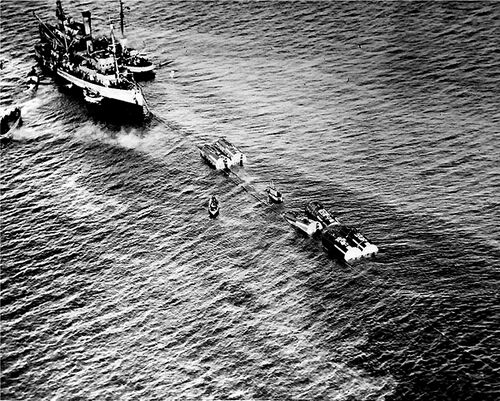
The salvage operation went remarkably well, all things considered. The Navy had learned a lot about open ocean salvage during the S-51 operation two years prior. Those lessons greatly sped the S-4 operation, and she was off the bottom in a little over three months, as opposed to the 9½ months for the S-51.
Please see the Jim Christley article at this link for the story of the S-4.
U.S. Navy photo.
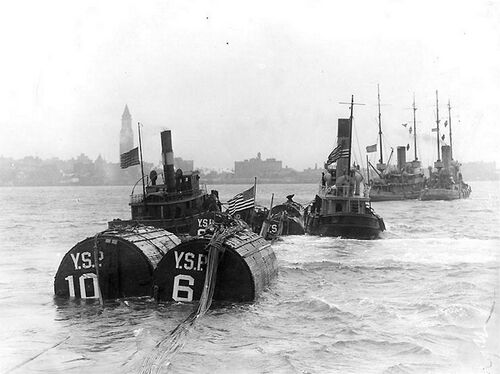
U.S. Navy photo.
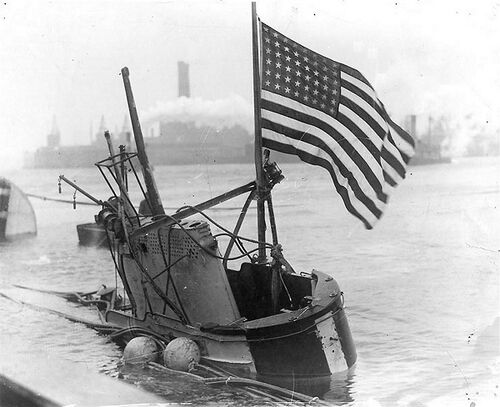
U.S. Navy photo.
The Move into Drydock
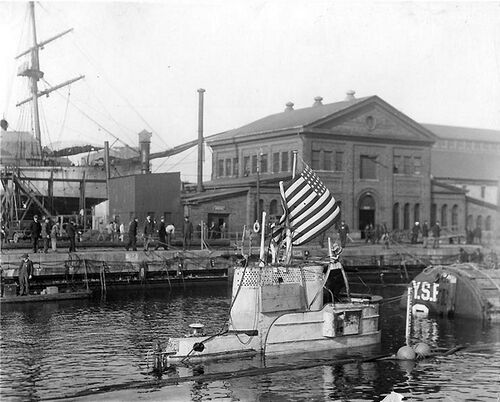
U.S. Navy photo.

U.S. Navy photo.
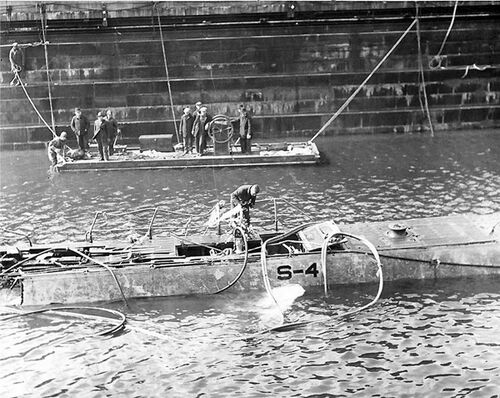
U.S. Navy photo.
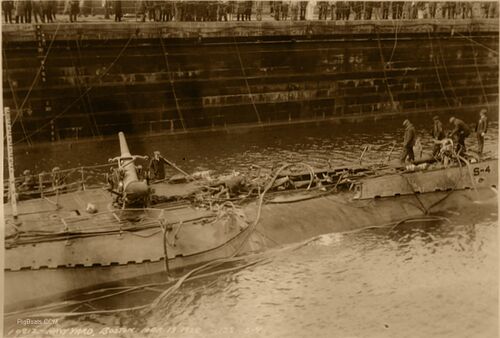
Of historical note in this photo is the cover that is in place over the breech end of the 4"/50 caliber gun. This cover is not seen in most photos. It was found that the breech mechanism was hardier than originally thought and that the cover was not necessary. It was deleted from most of the submarine guns that used it.
Image provided courtesy of the Stephen B. Luce Library, SUNY Maritime College, Papers of John S. Baylis.
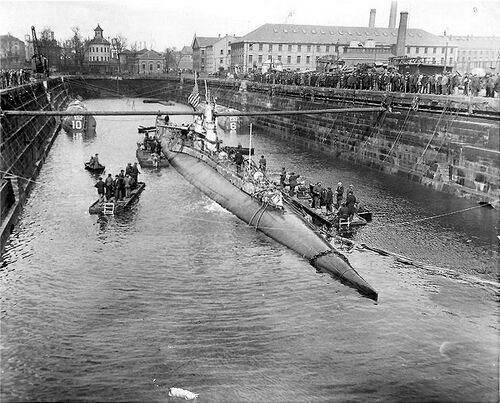
U.S. Navy photo
-
Image provided courtesy of the Stephen B. Luce Library, SUNY Maritime College, Papers of John S. Baylis via Joe Williams.
-
Image courtesy of the Massachusetts Digital Commonwealth.
Damage Assessment and Inspection
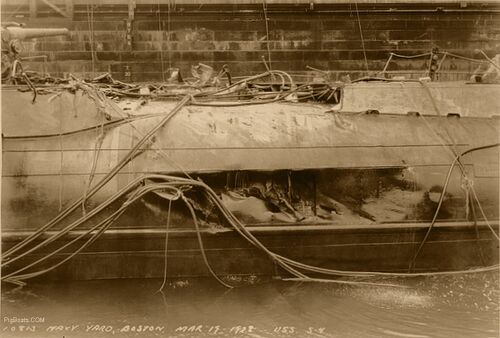
Image provided courtesy of the Stephen B. Luce Library, SUNY Maritime College, Papers of John S. Baylis via Joe Williams.
-
U.S. Navy photo.
-
U.S. Navy photo.
-
Image provided courtesy of the Stephen B. Luce Library, SUNY Maritime College, Papers of John S. Baylis via Joe Williams.
-
Image provided courtesy of the Stephen B. Luce Library, SUNY Maritime College, Papers of John S. Baylis via Joe Williams.
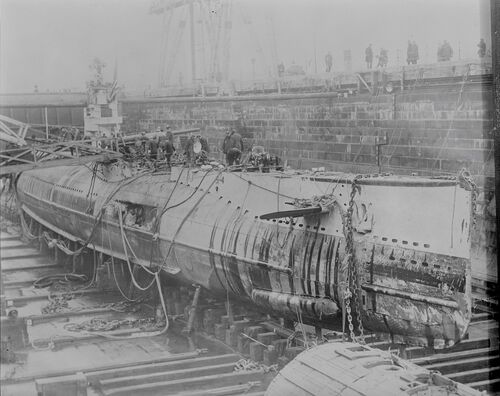
The long sausage looking object on the hull below the waterline beneath the bow planes is a MV sonar, a replacement for the earlier Y-tube mounted on the main deck forward. It was a line array of 12 microphones and was electronically steered. A duplicate array was on the port side.
Photo courtesy of the Massachusetts Digital Commonwealth.
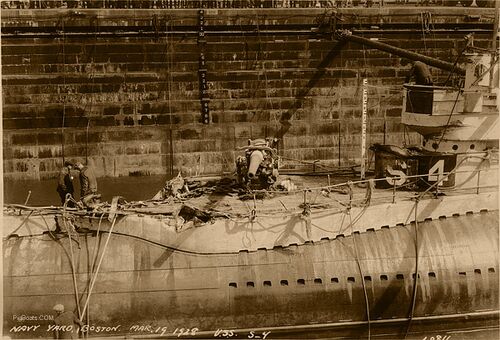
Image provided courtesy of the Stephen B. Luce Library, SUNY Maritime College, Papers of John S. Baylis via Joe Williams.
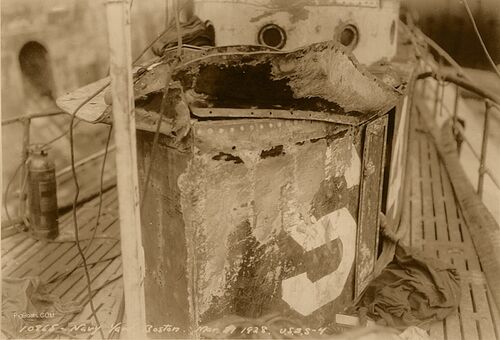
Image provided courtesy of the Stephen B. Luce Library, SUNY Maritime College, Papers of John S. Baylis via Joe Williams.
U.S. Navy photos.
U.S. Navy photos.
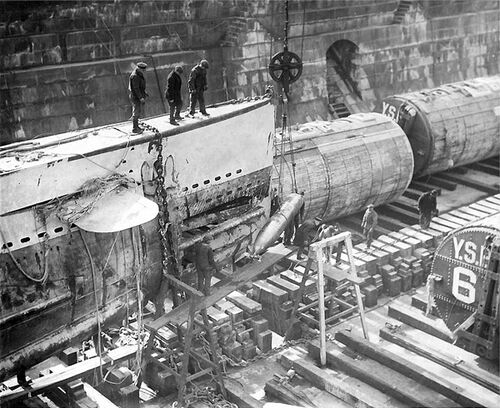
U.S. Navy photo.
Images courtesy of the Massachusetts Digital Commonwealth.
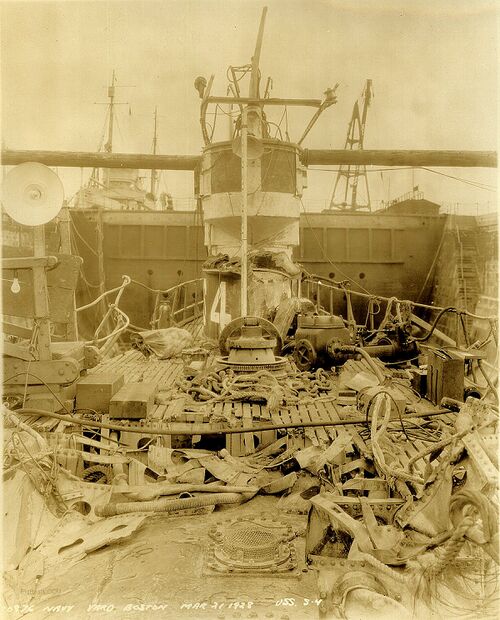
Image provided courtesy of the Stephen B. Luce Library, SUNY Maritime College, Papers of John S. Baylis via Joe Williams.
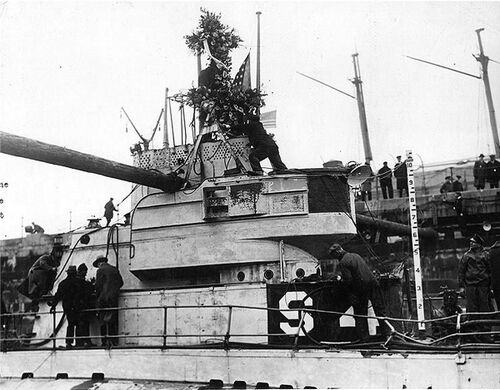
U.S. Navy photo.
Interior Photos of the Damage

S-4 flooded through a hole, made by Paulding's bow, in the forward starboard side of the Battery Room.
U.S. Navy photo.
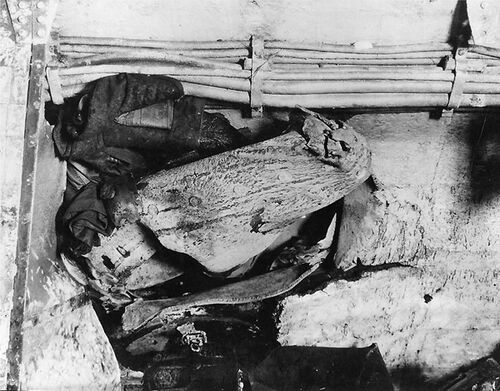
U.S. Navy photo.
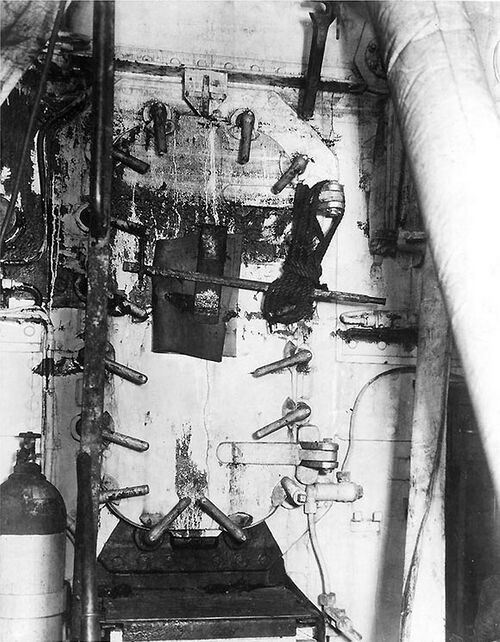
The six men in this compartment were;
Lieutenant Graham N. Fitch
Torpedoman's Mate Russell A. Crabb
Seaman Joseph L. Stevens
Seaman George Pelnar
Torpedoman's Mate Roger L. Short
Torpedoman's Mate Frank Snizek
As the trapped men used the last of available oxygen in the sub's torpedo room, a diver placed his helmeted ear to the side of the vessel and received this Morse-coded message, “Is … there … any … hope?” Unfortunately, the ultimate answer was "no". All six men died.
As a result of these first sinkings the doors used in submarines were redesigned smaller and heavier and existing boats were retrofitted with these over time. New submarines were designed with the smaller doors.
U.S. Navy photo, copy in the collection of Ric Hedman.
The Aftermath

The two men are proudly displaying the S-4's bell, recovered from the wreck by Eadie.
Photo in the private collection of Ric Hedman.
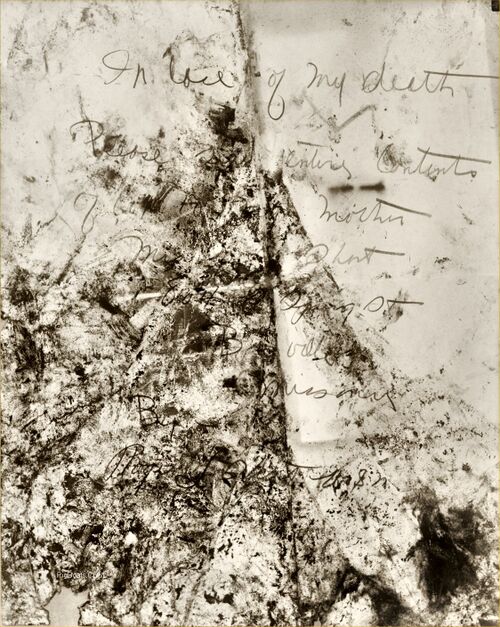
The letter says: In case of my death please send entire contents of box to my mother Mrs. (unreadable) Short 804 (unreadable) Spring St. Booneville, Missouri. By Roger L. Short U.S.N.
Courtesy of the Boston Public Library, Leslie Jones Collection.
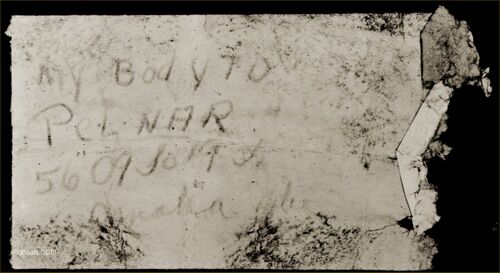
Seaman George Pelnar had only been aboard for 21 days at the time of sinking.
Courtesy of the Boston Public Library, Leslie Jones Collection.
The Crew
-
Walter Bishop
-
Henry Handy Brown
-
Charles Frederick Burrell
-
Charles Beresford Calcott
-
William Franklin Callaway
-
Graham Newell Fitch
-
Charles A. Ford / Civilian
-
Daniel Michael Gavin
-
Dewey Victor Haney
-
Aaron A. Hodges w/Uncle
-
Roy Kehlor Jones
-
Joseph Alfred McGinley
-
John Jospeh Powers
-
Roger Leslie Short
-
Frank Snizek
-
Joseph William Sternman
-
Joseph Leighton Stevens
-
Donald Weller
Other lost crew with no photo:
Clarence Ferdinand Bethke / Earl Welsh Boone / Elmer Lyfford Cash / Russell Archibald Crabb / William Dempsey / Robert William Diefenbach / John Joseph Fennell / Donald Fred Goering / Peder Haaland / Buster Harris / Arthur Frederick Hodges / Paul Richard Kempfer / J. H. Long / Fred Henry O'Shields / George Pelnar / Rudolf James Rose / Alfred Eugene Seaton / Carl Bernice Strange / Mariano Tedar / Carl Harold Thompson / Walter Ross Tolson / James Johnson White
Photos courtesy of the On Eternal Patrol website
Page created by:
Ric Hedman & David Johnston
1999 - 2023 - PigBoats.COM©
Mountlake Terrace, WA, Norfolk, VA
webmaster at pigboats dot com

